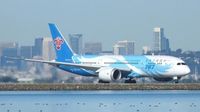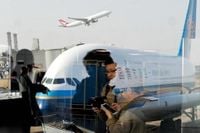On the heels of deepening trade tensions between China and the United States, a new battleground has emerged high above the clouds: the air routes connecting the world’s two largest economies. In October 2025, a U.S. proposal to ban Chinese airlines from flying over Russian airspace on routes to and from the United States has sparked a fierce backlash from China’s major carriers, government officials, and industry analysts alike, setting the stage for another chapter in the ongoing saga of China-U.S. relations.
The controversy began when the U.S. Department of Transportation (DOT) put forward a plan to prohibit Chinese airlines from traversing Russian skies on their way to American destinations. The rationale, according to U.S. officials, is that since 2022—when Russia closed its airspace to U.S. airlines in response to Western sanctions over the Ukraine invasion—American carriers have been forced to take longer, more costly routes to Asia. Meanwhile, Chinese airlines, unencumbered by such restrictions, have continued to fly more direct routes over Russia, giving them a clear competitive edge in both time and cost. The DOT has indicated that the final order could take effect as soon as November 2025, a timeline that has only heightened the sense of urgency among stakeholders on both sides of the Pacific.
Chinese airlines wasted no time in voicing their objections. On October 16, six major state-owned carriers—including Air China, China Eastern, China Southern, Hainan Airlines, Sichuan Airlines, and Xiamen Airlines—filed a formal complaint with the DOT. They argued that the proposed ban would not only extend flight times by two to three hours on key routes, but also disrupt the travel plans of thousands of passengers, especially during the busy Thanksgiving, Christmas, and Chinese New Year holidays. According to filings, Air China estimated that "at least 4,400 passengers hold Air China tickets" in the next two months, and the disruption would "impact passenger rights." China Eastern, which operates the most weekly flights to the U.S., warned that the ban "would extend the flight time on [its] most important routes by two to three hours." China Southern projected that nearly 3,000 passengers scheduled to travel over the holiday season "would need to be re-booked, jeopardizing their travel plans." And in a nod to environmental concerns, Hainan Airlines noted that "increased flight distances and higher fuel consumption will result in greater carbon emissions."
Beyond the immediate logistical headaches, the Chinese government has taken a strong stance against the proposal. Chinese Foreign Ministry spokesperson Lin Jian, speaking at a press conference on October 15, asserted that "the U.S. imposing restrictions on the operations of Chinese carriers is not conducive to exchanges between the two countries' people and also harms the U.S.' own interests." Lin further emphasized that the move has been met with "numerous objections" within the United States itself, underscoring the potential for broader fallout. Echoing this sentiment, Chinese Foreign Minister Guo Jiakun told the South China Morning Post: "We would suggest that the U.S. side reflect on how its own policies are affecting American companies, rather than unjustifiably suppressing other countries and making global consumers pay the price."
The scale of the disruption is hard to overstate. Chinese airlines currently operate 81 weekly flights to major U.S. destinations such as Los Angeles, New York JFK, Chicago, San Francisco, Boston, Seattle, and Honolulu. According to Cirium data, more than 200,000 monthly seats could be affected by the proposed ban. As of September 2025, there were 21 direct China-U.S. routes in operation, served by nine airlines—six Chinese and three American (United Airlines, American Airlines, and Delta Air Lines). Chinese carriers accounted for 50.73% of these services, with U.S. airlines making up the remaining 49.27%, according to travel services platform Flight Master.
Industry experts have also weighed in, warning that the ban would likely drive up airfares, force travelers onto connecting flights via Hong Kong, Japan, or South Korea, and take a significant toll on business and trade exchanges between the two countries. Qi Qi, a senior independent civil aviation industry analyst, described the U.S. demand as "highly unreasonable and unprofessional," noting that rerouting flights requires considerable time for assessment. "In contrast, the response of the Chinese airlines has been professional and based on scientific considerations. It is hoped that the U.S. will approach this matter with greater rationality and align its considerations with practical feasibility," Qi said in China Daily.
From the American perspective, however, the proposed ban is seen as a necessary step to level the playing field. U.S. airlines, including Delta and United, have come out strongly in support of the DOT’s proposal. A Delta spokesperson stated that the airline "commends" the DOT's move, adding that it "will help ensure a more level playing field." United Airlines has gone even further, urging the DOT to extend the prohibition to other carriers, such as Hong Kong-based Cathay Pacific, which also fly over Russia on flights to the U.S. United argues that the Russia restrictions mean it is "effectively barred from resuming non-stop service on previously served routes such as Newark, Washington DC, and Chicago."
Interestingly, the ripple effects of the U.S. proposal are already being felt beyond North America. European airlines, too, are considering similar restrictions. Carsten Spohr, CEO of Lufthansa, has called for all airlines landing in Europe to be "required to avoid Russian airspace," and executives from Air France-KLM, British Airways, and SAS have echoed this sentiment. Given that Chinese airlines fly hundreds of flights each week on over 70 routes to Europe, their cost advantage from being able to traverse Russian airspace is even greater on those routes than on U.S. flights.
As the debate rages on, some analysts have pointed out that the U.S. DOT set an unusually short comment period for Chinese airlines to respond to the order—just two business days. In response, seven Chinese carriers (including Capital Airlines, which is not currently operating U.S. flights) requested an extension to seven business days to complete their impact assessments and prepare meaningful responses. Air China, in particular, highlighted the need for more time to analyze the potential consequences for passengers and operations.
Lin Zhijie, an independent civil aviation industry analyst, summed up the stakes succinctly: "If China-U.S. flights were rerouted, travel time would increase by several hours and airfares would rise further. This will undoubtedly take a significant toll on business and trade exchanges between the two countries." He also noted that, currently, only U.S. airlines are authorized to operate U.S.-China routes with a stopover in Tokyo, suggesting that reciprocity should allow Chinese airlines similar rights.
With the final DOT order potentially coming into force as early as November 2025, the clock is ticking for policymakers, airlines, and travelers alike. The skies between China and the U.S. have always been busy, but rarely have they been so fraught with political turbulence. As both sides dig in, the fate of hundreds of thousands of passengers—and the broader future of China-U.S. aviation ties—hangs in the balance.





